ICIClientSettings Interface
The ICIClientSettings interface displays the user properties defined for a user in EFT.
interface ICIClientSettings : IDispatch
Use the ICISite interface GetUserSettings or GetSettingsLevelSettings methods to manage user account or Settings Template configuration.
See also ClientDataField enum.
Example:
Set oUser = oSite.GetUserSettings(aUsr(j))
Set 0SettingsLevel = oSite.GetSettingsLevelSettings("Default Settings")
Once you obtain a handle to the user or Settings Template configuration, you can Get or Set permissions for that user or Settings Template.
See also:
Difference Between VARIANT_BOOL and SFTPAdvBool
Scroll down to see the dialog box equivalents; Refer to Workspaces Settings for details of Settings Template and user Workspaces settings.
Example of using the Custom property
For SFTPAdvBool, used in properties below:
-
abFalse = 0
-
abInherited = -2
-
abTrue = 1
Jump to: C E F G I L M P R S U
Property AccountCreationTime As Date
Retrieves date the user account was created.
HRESULT AccountCreationTime([out, retval] DATE* pVal);
MsgBox "Account creation time: " & CStr(oClientSettings.AccountCreationTime)
EFT v6.3 and later
Sub AddIPAccessRule(bstrMask As String, bAllow As Boolean, nRulePos As Long, [bstrReason As String = ""])
Adds allowed (true) or denied (false) IP mask for the client.
HRESULT AddIPAccessRule(
[in] BSTR bstrMask,
[in] VARIANT_BOOL bAllow,
[in] long nRulePos,
[in, defaultvalue("")] BSTR bstrReason);
VARIANT_BOOL equals TRUE(-1) when it is allowed and FALSE(0) when it is denied (defaultvalue and Reason added in EFT v8)
Example (C#):
client.AddIPAccessRule("1.1.1.2", true, 0);
For an example using this method, refer to the ServerIPBanEntry script in Script Examples.
See also the following interfaces:
ICIAutobanIPAccessRule Interface
ICIManualIPAccessRule Interface
EFT v5.1.1 and later
Property AS2InboundSettings As CIAS2InboundSettings
Retrieves user account's AS2 inbound settings.
HRESULT AS2InboundSettings( [out,retval] IDispatch** pSttg); (v6.3 - 6.3.3) [out,retval] ICIAS2InboundSettings** pSttg);
Example (VBScript):
Set oAS2InboundSettings = oClientSettings.AS2InboundSettings
EFT v6.3 and later
Property AS2OutboundSettings As CIAS2OutboundSettings
Retrieves user account's AS2 outbound settings.
HRESULT AS2OutboundSettings( [out,retval] IDispatch** pSttg); (v6.3 - 6.3.3)
Example (VBScript):
Set oAS2OutboundSettings = oClientSettings.AS2OutboundSettings
EFT v6.3 and later
Function AS2TestOutboundProfile() As AS2OutboundProfileStatus
Tests user account's AS2 outbound profile and returns status.
HRESULT AS2TestOutboundProfile( [out,retval] AS2OutboundProfileStatus* pVal);
Example (VBScript):
if AS2StatusOk = oClientSettings.AS2TestOutboundProfile then MsgBox “Success.” else MsgBox “Some going wrong.” end if
EFT v6.3 and later
Property Comment As String
Retrieve comments for a user account:
HRESULT Comment([out, retval] BSTR *pVal);
HRESULT Comment([in] BSTR newVal);
All versions
Property CompanyName As String
Retrieve or modify Company Name for a user account:
HRESULT CompanyName ([out, retval] BSTR *pVal);
HRESULT CompanyName ([in] BSTR newVal);
Example (VBScript):
Wscript.echo oUser.CompanyName oUser.CompanyName = “Company”
EFT v8 and later
Property Custom1 As String; Property Custom2 As String; Property Custom3 As String
(See the example.)
Retrieve the custom fields of a user account.
HRESULT Custom1([out, retval] BSTR *pVal);
HRESULT Custom1([in] BSTR newVal);
EFT v5.0.1 and later
Retrieve or modify a user account' DUNS.
HRESULT Duns([out, retval] BSTR *pVal);
HRESULT Duns([in] BSTR newVal);
Example (VBScript):
Wscript.echo oUser.Duns oUser. Duns = “123456”
EFT v8 and later
Property Email As String
Retrieve a user's email address.
HRESULT Email(out, retval] BSTR *pVal);
HRESULT Email([in] BSTR newVal);
All versions
Property Fax As String
Retrieve a user's fax number.
HRESULT Fax([out, retval] BSTR *pVal);
HRESULT Fax([in] BSTR newVal);
All versions
Sub ForcePasswordChange()
Forces the user to change the account password on the next login.
HRESULT ForcePasswordChange();
EFT v6.0 and later
Property FullName As String
Retrieve a user's full name.
HRESULT FullName([out, retval] BSTR *pVal); HRESULT FullName([in] BSTR newVal);
All versions
Retrieve or modify mobile number for a user account:
HRESULT Mobile ([out, retval] BSTR *pVal);
HRESULT Mobile ([in] BSTR newVal);
Example (VBScript):
Wscript.echo oUser.Mobile oUser.Mobile = “123456”
EFT v8 and later
Function GetAllowCOMB(pInherited) As Boolean
Sub SetAllowCOMB(val
As SFTPAdvBool)
Retrieve/Set whether the COMB command is allowed.
HRESULT GetAllowCOMB( [out] VARIANT *pInherited, [out,retval] VARIANT_BOOL *pVal);
HRESULT SetAllowCOMB(SFTPAdvBool val);
VARIANT_BOOL equals TRUE(-1) when it is allowed and FALSE(0) when it is not allowed.
Examples (VBScript):
bEnabled = oClientSettings.GetAllowCOMB(bInherited) MsgBox "Enabled: " & CStr(bEnabled) & " Inherited: " & CStr(bInherited)oClientSettings.SetAllowCOMB abTrue
(For information about using the COMB command with EFT, refer to "Allowing Multipart Transfers (COMB Command)" in the EFT Installation, Administration, and User Guide.)
EFT v6.3 and later
Function GetAllowFXP(pInherited)
As Boolean
Sub SetAllowFXP(val
As SFTPAdvBool)
Retrieve/Specify whether site-to-site transfers are allowed.
Example (VBScript):
HRESULT GetAllowFXP([out] VARIANT *pInherited,[out,retval] VARIANT_BOOL *pVal);
oClientSettings.SetAllowCOMB abFalse HRESULT SetAllowFXP(SFTPAdvBool val);
VARIANT_BOOL equals TRUE(-1) when it is allowed and FALSE(0) when it is not allowed.
EFT v6.3 and later
Function GetAllowMODEZ([pInherited])
As Boolean
Sub SetAllowMODEZ(val
As SFTPAdvBool)
Retrieve/Specify whether Allow Mode Z for the client is ON or OFF.
HRESULT GetAllowMODEZ([out, optional] VARIANT *pInherited, [out, retval] VARIANT_BOOL *pVal);
You can also pass in an optional BOOLEAN variable as a parameter to this function; when the function returns, this optional parameter contains the INHERITED status of this feature.
HRESULT SetAllowMODEZ([in] SFTPAdvBool val);
All versions
Function GetAllowNoop([pInherited])
As Boolean
Sub SetAllowNoop(val
As SFTPAdvBool)
Retrieve/Specify whether a user can send the NOOP command to keep a connection open. Use the same method to prohibit the user from sending the NOOP command.
HRESULT GetAllowNoop( [out, optional] VARIANT *pInherited, [out, retval] VARIANT_BOOL *pVal);
VARIANT_BOOL equals True(-1) = Enabled; False(0) = Disabled
HRESULT SetAllowNoop([in] SFTPAdvBool val);
All versions
Function GetAllowXCRC([pInherited])
As Boolean
Sub SetAllowXCRC(val
As SFTPAdvBool)
Retrieve/specify whether a user is allowed to send the XCRC command to confirm transfers. Use the same method to prohibit the user from sending the XCRC command.
HRESULT GetAllowXCRC([out, optional] VARIANT *pInherited, [out, retval] VARIANT_BOOL *pVal);
VARIANT_BOOL equals True(-1) = Enabled; False (0) = Disabled
HRESULT SetAllowXCRC([in] SFTPAdvBool val);
All versions
Function
GetAllowWorkspaces As Boolean
Function SetAllowWorkspaces As Boolean
Retrieves/specifies whether user account or Settings Template is allowed to create Workspaces.
HRESULT GetAllowWorkspaces([out, optional] VARIANT *pInherited, [out, retval] VARIANT_BOOL *pVal);
HRESULT SetAllowWorkspaces([in] SFTPAdvBool val);
EFT v7.3.3
Function
GetAllowWorkspacesOAI As Boolean
Function SetAllowWorkspacesOAI As Boolean
Retrieves/specifies whether user account or Settings Template is allowed to share files in Workspaces or Outlook
HRESULT GetAllowWorkspacesOAI([out, optional] VARIANT *pInherited, [out, retval] VARIANT_BOOL *pVal);
HRESULT SetAllowWorkspacesOAI([in] SFTPAdvBool val);
EFT v7.3.3
Function GetAppletEnabled([pInherited])
As Boolean
Sub SetAppletEnabled(val
As SFTPAdvBool)
Retrieve/specify EFT Web Transfer Client applet access setting for a user or Settings Template.
HRESULT GetAppletEnabled([out, optional]VARIANT *pInherited, [out, retval] VARIANT_BOOL *pVal);
VARIANT_BOOL equals True(-1) = Enabled; False(0) = Disabled
HRESULT SetAppletEnabled([in]SFTPAdvBool val);
Example, setting the state:
slSettings = SetSettingsLevelSettings("Default Settings") bEnabled = slSettings.SetAppletEnabled( bInherited )
Example for v6.1 and later:
If Client.AppletEnabled(isInherited) And isInherited Then MsgBox "WTC is allowed for client because it is allowed for Settings Template" End If
For an example using this method, refer to the GetCertInfo script in Script Examples.
EFT v3.5.1 and later
Function GetAS2Inbound([pInherited])
As Boolean
Sub SetAS2Inbound(val
As SFTPAdvBool)
Retrieve/specify whether AS2 inbound transactions are enabled for the user or Settings Template.
HRESULT GetAS2Inbound([out, optional] VARIANT* pInherited,[out, retval] VARIANT_BOOL* pVal);
VARIANT_BOOL equals True(-1) = Enabled; False(0) = Disabled
HRESULT SetAS2Inbound([in] SFTPAdvBool val);
Example (VBScript):
bEnabled = oClientSettings.GetAS2Inbound(bInherited) MsgBox "Enabled: " & CStr(bEnabled) & " Inherited: " & CStr(bInherited) oClientSettings.SetAS2Inbound abInherited
EFT v6.3 and later
Function GetAS2Outbound([pInherited])
As Boolean
Sub SetAS2Outbound(val
As SFTPAdvBool)
Retrieve/specify whether AS2 outbound transactions are enabled for the user or Settings Template.
HRESULT GetAS2Outbound([out, optional] VARIANT* pInherited,[out, retval] VARIANT_BOOL* pVal);
VARIANT_BOOL equals True(-1) = Enabled; False(0) = Disabled
HRESULT SetAS2Outbound([in] SFTPAdvBool val);
Example (VBScript):
bEnabled = oClientSettings.GetAS2Outbound(bInherited) MsgBox "Enabled: " & CStr(bEnabled) & " Inherited: " & CStr(bInherited) oClientSettings.SetAS2Outbound abTrue
EFT v6.3 and later
Function GetChangePwd([pInherited])
As Boolean
Sub SetChangePwd(val
As SFTPAdvBool)
Allow or determine if users can change their passwords. Use the same method to prohibit the user from changing passwords.
HRESULT GetChangePwd([out, optional] VARIANT *pInherited, [out, retval] VARIANT_BOOL *pVal);
VARIANT_BOOL equals True(-1) = Enabled; False(0) = Disabled
HRESULT SetChangePwd([in] SFTPAdvBool val);
All versions
Function GetClearFTP([pInherited])
As Boolean
Sub SetClearFTP(val
As SFTPAdvBool)
Determine or allow if a user account can make connections using insecure FTP.
HRESULT GetClearFTP([out, optional] VARIANT *pInherited, [out, retval] VARIANT_BOOL *pVal);
VARIANT_BOOL equals True(-1) = Enabled; False(0) = Disabled
HRESULT SetClearFTP([in] SFTPAdvBool val);
All versions
Function GetClearHTTP([pInherited])
As Boolean
Sub SetClearHTTP(val
As SFTPAdvBool)
Allow or determine if a user account can make connections using insecure HTTP.
HRESULT GetClearHTTP([out, optional] VARIANT *pInherited,[out, retval] VARIANT_BOOL *pVal);
VARIANT_BOOL equals True(-1) = Enabled; False(0) = Disabled
HRESULT SetClearHTTP([in]SFTPAdvBool val);
EFT v4.3.4 and EFT v5.1 and later
Function
GetComplexPasswordSettings()
As CIComplexPasswordSettings
Sub
SetComplexPasswordSettings(pIComplexPasswordSettings
As CIComplexPasswordSettings)
Retrieve/specify complex password settings for a user or Settings Template.
HRESULT GetComplexPasswordSettings( [out, retval] IDispatch** ppIComplexPasswordSettings) HRESULT SetComplexPasswordSettings( [in] IDispatch* pIComplexPasswordSettings)
Examples (VBScript):
Set oComplexPwdSettings = oClientSettings.GetComplexPasswordSettings(); oClientSettings.SetComplexPasswordSettings oComplexPwdSettings;
EFT v6.3 and later
Function GetDescription()
As String
Sub SetDescription(bstrVal
As String)
Retrieve or provide the description for a user or User Settings Template.
HRESULT GetDescription([out, retval] BSTR *prop); HRESULT SetDescription([in] BSTR bstrVal);
All versions
Function GetDownloadsPerSession([pInherited])
As Long
Sub SetDownloadsPerSession(val
As Long)
Determine/specify the maximum number of downloads a user is permitted per session.
HRESULT GetDownloadsPerSession( [out, optional] VARIANT *pInherited, [out, retval] long *pVal); HRESULT SetDownloadsPerSession([in] long val);
All versions
Function GetEnableAccount([pInherited])
As Boolean
Sub SetEnableAccount(val
As SFTPAdvBool)
Determine/specify if a user account or Settings Template is enabled.
HRESULT GetEnableAccount( [out, optional] VARIANT *pInherited, [out, retval] VARIANT_BOOL *pVal);
VARIANT_BOOL equals True(-1) = Enabled; False(0) = Disabled
HRESULT SetEnableAccount([in] SFTPAdvBool val);
You need to obtain a handle to the specific user or Settings Template from ICISite's GetUserSettings method or ICISite's GetSettingsLevelSettings method before you can perform an action upon that user or Settings Template.
Below is a sample code snippet using PHP that demonstrates this technique:
<?php
// first create server object
$Server = new COM("SFTPCOMInterface.CIServer") or die("Unable to
instantiate Server");// connect to server
$Server->Connect("localhost",1000,"admin","admin");// get handle to list of sites
$Sites = $Server->Sites();// chose your site. On most one-site systems this will be "0"
$MySite = $Sites->Item(0);// Pull the settings for the user that you want.
$Settings = $MySite->GetUserSettings("juser");// enable or disable or inherit.
// Enable is 1. Disable is 0. Inherit is -2
// Notice that you apply this to the settings for the user that you just pulled
$Settings->SetEnableAccount(1);// Be sure to apply the settings or else nothing will really change
$Server->ApplyChanges();
// close the connection.
$Server->Close();
?>
All versions
Function GetEnableDiskQuota([pInherited])
As Boolean
Sub SetEnableDiskQuota(val
As SFTPAdvBool)
Determine if a user account's home folder space is restricted or limit the amount of space a user can use in a home folder.
HRESULT GetEnableDiskQuota( [out, optional] VARIANT *pInherited, [out, retval] VARIANT_BOOL *pVal);
VARIANT_BOOL equals True(-1) = Enabled; False(0) = Disabled
HRESULT SetEnableDiskQuota([in] SFTPAdvBool val);
All versions
Function GetEnablePasswordHistory([pInherited])
As Boolean
Sub SetEnablePasswordHistory(val
As SFTPAdvBool)
Determine/specify if password reuse is allowed.
HRESULT GetEnablePasswordHistory( [out, optional] VARIANT *pInherited, [out, retval] VARIANT_BOOL *pVal);
VARIANT_BOOL equals True(-1) = Enabled; False(0) = Disabled
HRESULT SetEnablePasswordHistory(SFTPAdvBool val);
Example (VBScript):
bEnable = oClientSettings.GetEnablePasswordHistory(bInherited) oClientSettings.SetEnablePasswordHistory abTrue
EFT v6.3 and later
Function GetEnableTimeOut([pInherited])
As Boolean
Sub SetEnableTimeOut(val
As SFTPAdvBool)
Determine if or enable a time out after a user connection is inactive too long.
HRESULT GetEnableTimeOut( [out, optional] VARIANT *pInherited, [out, retval] VARIANT_BOOL *pVal);
VARIANT_BOOL equals True(-1) = Enabled; False(0) = Disabled
HRESULT SetEnableTimeOut([in] SFTPAdvBool val);
All versions
Function
GetExpirationDate(dDate)
As Boolean
Sub SetExpirationDate(dDate, bEnable
As Boolean)
Determine/specify whether an expiration date is set for a particular user account. (Set the expiration date with SetExpirationDate.)
HRESULT GetExpirationDate( [out]VARIANT *dDate, [out, retval] VARIANT_BOOL *pVal); HRESULT SetExpirationDate( [in] VARIANT *dDate, [in]VARIANT_BOOL bEnable);
VARIANT_BOOL equals True(-1) = Enabled; False(0) = Disabled
Examples:
PHP 5 example (uses a VARIANT rather than a STRING to set the expiration date):
$expiredate = "05/15/2005"; $enableexpiration = 1; $vtdate = new VARIANT($expiredate, VT_DATE); $UserSettings->SetExpirationDate($expiredate, $enableexpiration);
VBScrip):
sUser = "q"
sExpirationDate = "Never"
If Site.GetUserSettings(sUser).GetExpirationDate(expirationDate)
Then
sExpirationDate = CStr(expirationDate)
End If
MsgBox "Account " & sUser & " expiration date: " &
sExpirationDate
Set client_settings = Site.GetUserSettings("testuser")
client_settings.SetExpirationDate
CDate(FormatDateTime("15/05/2005")),True
All versions
Function GetExpirationDateAsVariant()
As Variant
Determine the expiration date for a particular user account, set with
SetExpirationDate.
HRESULT GetExpirationDateAsVariant([out, retval]VARIANT *dDate);
Example:
Dim strUser: strUser = "test" set oUserSettings = oSite.GetUserSettings(strUser) dtAccExpDate = oUserSettings.GetExpirationDateAsVariant() WScript.Echo ("dtAccExpDate = " & dtAccExpDate)
EFT v4.3.4 and later
Function GetForcePasswordResetOnInitialLogin([pInherited])
As Boolean
Sub SetForcePasswordResetOnInitialLogin(val
As Boolean)
Retrieve or specify whether the option to force the user to change their password on next login is on. If the option allowing this client to change their password is not inherited (i.e., is set to value other than abInherited), this option override the Site’s ForcePasswordResetOnInitialLogin value. If the option is ON, it does not mean the user will necessarily be forced to change the password on next login, because the user’s password might be already changed since the admin had switched the option from OFF to ON. To unconditionally force the user to change password on next login, use ICIClientSettings::ForcePasswordChange method.
HRESULT GetForcePasswordResetOnInitialLogin( [out, optional] VARIANT *pInherited, [out, retval] VARIANT_BOOL *pVal); HRESULT SetForcePasswordResetOnInitialLogin( [in] VARIANT_BOOL val);
VARIANT_BOOL equals True(-1) = Enabled; False(0) = Disabled
Example (VBScript):
Specifying:
client.SetChangePwd abTrue ‘override “Allow change password” option first client.SetForcePasswordResetOnInitialLogin False
If client.GetForcePasswordResetOnInitialLogin(isInherited) Then If isInherited Then MsgBox "The option to reset password is turned on from site" End If End If
EFT v6.2 and later
Function
GetForcePasswordResetOnNextLogin() As Boolean
Sub SetForcePasswordResetOnNextLogin(val As SFTPAdvBool)
HRESULT GetForcePasswordResetOnNextLogin( [out, retval] VARIANT_BOOL *pVal); HRESULT SetForcePasswordResetOnNextLogin( [in] SFTPAdvBool val);
See also Script Examples.
EFT v7.4 and later
Function GetFTPS([pInherited])
As Boolean
Sub SetFTPS(val
As SFTPAdvBool)
Retrieve/enable/disable whether access is enabled for a client.
HRESULT GetFTPS( [out, optional] VARIANT *pInherited, [out, retval] VARIANT_BOOL *pVal);
VARIANT_BOOL equals True(-1) = Enabled; False(0) = Disabled
HRESULT SetFTPS([in] SFTPAdvBool val);
EFT v6.0 and later
Function
GetGDPRPrivacyPolicyConsentStatus()
As GDPRPrivacyPolicyConsentStatus
Sub SetGDPRPrivacyPolicyConsentStatus(newVal
As GDPRPrivacyPolicyConsentStatus)
Retrieve/specify the Privacy Policy consent status for a client.
HRESULT GetGDPRPrivacyPolicyConsentStatus( [out, retval] GDPRPrivacyPolicyConsentStatus *pVal); HRESULT SetGDPRPrivacyPolicyConsentStatus( [in] GDPRPrivacyPolicyConsentStatus newVal);
Example (VBScript):
Wscript.echo oUser.GetGDPRPrivacyPolicyConsentStatus() Wscript.echo oUser.SetGDPRPrivacyPolicyConsentStatus (PPConsent_Granted_explicit)
EFT v8 and later
Function
GetGDPRSubjectStatus() As
GDPRSubjectStatus
Sub SetGDPRSubjectStatus(newVal
As GDPRSubjectStatus)
Retrieve/specify GDPR Subject status for a client.
HRESULT GetGDPRSubjectStatus(
[out, retval] GDPRSubjectStatus *pVal);
HRESULT SetGDPRSubjectStatus(
{in] GDPRSubjectStatus newVal);
Examples (VBScript):
Wscript.echo oUser.GetGDPRSubjectStatus() Wscript.echo oUser.SetGDPRSubjectStatus(Subject_Yes)
EFT v8 and later
Function
GetGDPRTermsOfServiceConsentStatus()
As GDPRTermsOfServiceConsentStatus
Sub SetGDPRTermsOfServiceConsentStatus(newVal
As GDPRTermsOfServiceConsentStatus)
Retrieve/specify the Terms of Service consent status for a client.
HRESULT GetGDPRTermsOfServiceConsentStatus( [out, retval] GDPRTermsOfServiceConsentStatus *pVal); HRESULT SetGDPRTermsOfServiceConsentStatus( [in] GDPRTermsOfServiceConsentStatus newVal);
Example (VBScript):
Wscript.echo oUser. GetGDPRTermsOfServiceConsentStatus() Wscript.echo oUser. SetGDPRTermsOfServiceConsentStatus (ToSConsent_Disagreed)
EFT v8 and later
Function GetHasDownloadsPerSession([pInherited])
As Boolean
Sub SetHasDownloadsPerSession(val
As SFTPAdvBool)
Determine or limit number of files a user is allowed to download per session.
HRESULT GetHasDownloadsPerSession( [out, optional] VARIANT *pInherited, [out, retval] VARIANT_BOOL *pVal);
VARIANT_BOOL equals True(-1) = Enabled; False(0) = Disabled
HRESULT SetHasDownloadsPerSession([in] SFTPAdvBool val);
All versions
Function GetHasMaxDownloadSize([pInherited])
As Boolean
Sub SetHasDownloadsPerSession(val
As SFTPAdvBool)
Determine or limit maximum file size a user is allowed to download.
HRESULT GetHasMaxDownloadSize([out, optional] VARIANT *pInherited,[out, retval] VARIANT_BOOL *pVal);
VARIANT_BOOL equals True(-1) = Enabled; False(0) = Disabled
HRESULT SetHasMaxDownloadSize([in] SFTPAdvBool val);
All versions
Function GetHasMaxIPs([pInherited])
As Boolean
Sub SetHasMaxIPs(val
As SFTPAdvBool)
Determine if or limit user or Settings Template maximum number of allowed concurrent connections from same IP.
HRESULT GetHasMaxIPs([out, optional] VARIANT *pInherited, [out, retval] VARIANT_BOOL *pVal);
VARIANT_BOOL equals True(-1) = Unlimited; False(0) = Limited
HRESULT SetHasMaxIPs([in] SFTPAdvBool val);
All versions
Function GetHasMaxSpeed([pInherited])
As Boolean
Sub SetHasMaxSpeed(val
As SFTPAdvBool)
Determine if or limit user account maximum allowed transfer speed.
HRESULT GetHasMaxSpeed([out, optional] VARIANT *pInherited, [out, retval] VARIANT_BOOL *pVal);
VARIANT_BOOL equals True(-1) =Maximum; False(0) = Not the maximum
HRESULT SetHasMaxSpeed([in] SFTPAdvBool val);
All versions
Function GetHasMaxUploadSize([pInherited])
As Boolean
Sub SetHasMaxUploadSize(val
As SFTPAdvBool)
Determine or limit maximum file size a user is allowed to upload.
HRESULT GetHasMaxUploadSize([out, optional] VARIANT *pInherited,[out, retval] VARIANT_BOOL *pVal);
VARIANT_BOOL equals True(-1) = Maximum; False(0) = Not the maximum
HRESULT SetHasMaxUploadSize([in] SFTPAdvBool val);
All versions
Function GetHasMaxUsers([pInherited])
As Boolean
Sub SetHasMaxUsers(val
As SFTPAdvBool)
Determine if or limit maximum number of allowed concurrent connections for a user.
HRESULT GetHasMaxUsers([out, optional] VARIANT *pInherited, [out, retval] VARIANT_BOOL *pVal);
VARIANT_BOOL equals True(-1) = Maximum; False(0) = Not maximum
HRESULT SetHasMaxUsers([in] SFTPAdvBool val);
All versions
Function GetHasPwdRetries([pInherited]) As Boolean
Sub SetHasPwdRetries(val
As SFTPAdvBool)
Determine or specify if a user account will be disabled after trying too many bad passwords in a row. Use the same method to allow an unlimited number of bad passwords.
HRESULT GetHasPwdRetries([out, optional] VARIANT *pInherited,[out, retval] VARIANT_BOOL *pVal);
VARIANT_BOOL equals True(-1) = Maximum; False(0) = Not maximum
HRESULT SetHasPwdRetries([in] SFTPAdvBool val);
All versions
Function GetHasUploadsPerSession([pInherited])
As Boolean
Sub SetHasUploadsPerSession(val
As SFTPAdvBool)
Determine if or limit maximum number of files a user is allowed to upload per session.
HRESULT GetHasUploadsPerSession([out, optional] VARIANT *pInherited,[out, retval] VARIANT_BOOL *pVal);
VARIANT_BOOL equals True(-1) = Maximum; False(0) = Not maximum
HRESULT SetHasUploadsPerSession([in] SFTPAdvBool val);
All versions
Function GetHomeDir([pInherited])
As Boolean
Sub SetHomeDir(val
As SFTPAdvBool)
Determine/specify if the user or User Settings Template can have a separate home folder.
HRESULT GetHomeDir([out, optional] VARIANT *pInherited,[out, retval] VARIANT_BOOL *pVal);
VARIANT_BOOL equals True(-1) = Enabled; False(0) = Disabled
HRESULT SetHomeDir([in] SFTPAdvBool val);
Examples (VBScript):
If client.GetHomeDir Then MsgBox "Client has separate home folder" End If client.SetHomeDir abInherited 'use home folder from Settings Template
All versions
Function GetHomeDirIsRoot([pInherited])
As Boolean
Sub SetHomeDirIsRoot(val
As SFTPAdvBool)
Determine or specify a user's default root folder.
HRESULT GetHomeDirIsRoot([out, optional] VARIANT *pInherited,[out, retval] VARIANT_BOOL *pVal);
VARIANT_BOOL equals True(-1) = Enabled; False(0) = Disabled
HRESULT SetHomeDirIsRoot([in] SFTPAdvBool val);
All versions
Function GetHomeDirString()
As String
Sub SetHomeDirString(bstrVal
As String)
Retrieve or specify the path to a user or User Settings Template home folder.
HRESULT GetHomeDirString([out, retval] BSTR *prop);
VARIANT_BOOL equals True(-1) = Enabled; False(0) = Disabled
HRESULT SetHomeDirString([in] BSTR bstrVal);
All versions
Function GetHTTPS([pInherited])
As Boolean
Sub SetHTTPS(val
As SFTPAdvBool)
Retrieve or specify whether access is enabled for a client.
HRESULT GetHTTPS([out, optional] VARIANT *pInherited, [out, retval] VARIANT_BOOL *pVal);
VARIANT_BOOL equals True(-1) = Enabled; False(0) = Disabled
HRESULT SetHTTPS([in] SFTPAdvBool val);
EFT v6.0 and later
Function GetInactiveAccountsMonitoring([pInherited])
As Boolean
Sub SetInactiveAccountsMonitoring(val
As SFTPAdvBool)
Retrieve or specify whether inactive accounts are disabled/removed after days of inactivity.
HRESULT GetInactiveAccountsMonitoring([out, optional] VARIANT* pInherited,[out, retval] VARIANT_BOOL* pVal);
VARIANT_BOOL equals True(-1) = Enabled; False(0) = Disabled
HRESULT SetInactiveAccountsMonitoring(SFTPAdvBool val);
Example (C#):
//Set inactivity monitoring userSettings.RemoveInactiveAccounts = true; userSettings.MaxInactivePeriod = 30; userSettings.SetInactiveAccountsMonitoring(SFTPAdvBool.abTrue);
Example (VBScript):
bEnable = oClientSettings.GetInactiveAccountsMonitoring (bInherited) oClientSettings.SetInactiveAccountsMonitoring abFalse
EFT v6.3 and later
Function GetIncorrectPasswordAttempts() As Long
Retrieve how many times a user has tried to connect with incorrect log in information.
HRESULT GetIncorrectPasswordAttempts([out, retval] long *pVal);
All versions
Function GetIPAccessRules() As Variant
See also the following interfaces:
ICIAutobanIPAccessRule Interface
ICIManualIPAccessRule Interface
ICIServer - Server Interface : GetIPAccessRules
ICISite - Single-Site Interface : GetIPAccessRules
Retrieves an array of client/template IP Access rules.
HRESULT GetIPAccessRules([out, retval] VARIANT *aMasks);
Example (VBScript):
The following script would retrieve a list of all IP addresses that have been banned automatically for a user or Settings template.
rules = oClientSettings.GetIPAccessRules() For Each key In rules If key.type = 0 Then WScript.echo "AutoBan" End if If key.type = 1 Then WScript.echo "Manual " + key.address End if Next
EFT v6.3 and later
Function
GetLimitAccessByIP([pInherited])
As Boolean
Sub SetLimitAccessByIP(val
As SFTPAdvBool)
Determine/specify if the IP Access Restriction List is enabled on the Settings Template or user account.
HRESULT GetLimitAccessByIP( [out, optional] VARIANT *pInherited, [out, retval] VARIANT_BOOL *pVal);
VARIANT_BOOL equals True(-1) = Enabled; False(0) = Disabled
HRESULT SetLimitAccessByIP( [in] SFTPAdvBool val);
Example (VBScript):
If client.GetLimitAccessByIP Then MsgBox "client’s Limit Access by IP is on" End If client.SetLimitAccessByIP abInherit
Example (VBScript); assigns IP address 1.1.1.1 to a client as an allowed IP address:
client.AddIPAccessRule "1.1.1.1", True 'Assign 'Allowed 'IP
EFT v6.1 and later
Function GetLimitLoginAttempts([pInherited])
As Boolean
Sub SetLimitLoginAttempts(val
As SFTPAdvBool)
Retrieve/specify whether recognize whether client will be penalized if he repeatedly tries to login with incorrect password.
HRESULT GetLimitLoginAttempts( [out, optional] VARIANT *pInherited, [out, retval] VARIANT_BOOL *pVal);
VARIANT_BOOL equals True(-1) = Enabled; False(0) = Disabled
HRESULT SetLimitLoginAttempts( [in] SFTPAdvBool val);
EFT v5.1.1 and later
Function GetLockoutNotDisable([pInherited])
As Boolean
Sub SetLockoutNotDisable(val
As Boolean)
Determine or specify if account lockout is enabled for a user.
HRESULT GetLockoutNotDisable([out, optional] VARIANT *pInherited,[out, retval] VARIANT_BOOL *pVal); HRESULT SetLockoutNotDisable([in] VARIANT_BOOL val);
VARIANT_BOOL equals True(-1) = Enabled; False(0) = Disabled
Example (VBScript):
client.SetLockoutNotDisable False
EFT v5.1.1 and later
Function GetLoginMsg()
As Long
Sub SetLoginMsg(val
As Long)
Determine or specify if the server uses the default log in message, adds a custom string to the default message, replaces the default message with a custom string, or if the server uses no login message.
HRESULT GetLoginMsg([out, retval] long *pVal); HRESULT SetLoginMsg([in] long val);
Values
-
0 = Use default
-
1 = Add to default
-
2 = Replace default
-
3 = None
Example (VBScript):
If client.GetLoginMsg = 3 Then MsgBox "No login banner will be shown for the client" End If
What is the difference between a connection banner and a login message?
EFT displays a connection banner immediately after a client connects via FTP, before requesting the login credentials. After the client provides the login credentials and the credentials are authenticated, EFT displays a login banner.
The default login banner is “Login OK, proceed.” At the Settings Template level, you can specify the following alternatives: use default (“Login OK, proceed.”) banner, append something to default (“Login OK, proceed.”) banner, use its own banner, and show no banner at all. At the user account level, you can specify the following alternatives: use default (the one formed at the Settings Template level) banner, append something to default (the one formed at Settings Template level) banner, use its own banner, and show no banner at all.
All versions
Function GetLoginMsgString()
As String
Sub SetLoginMsgString(bstrVal
As String)
Retrieve or create a login message.
HRESULT GetLoginMsgString([out, retval] BSTR *prop);
All versions
Function GetMaxDownloadSize([pInherited])
As Long
Sub SetMaxDownloadSize(val
As Long)
Determine/specify the maximum file size, in kilobytes, a user is allowed to download.
HRESULT GetMaxDownloadSize([out, optional] VARIANT *pInherited,[out, retval] long *pVal); HRESULT SetMaxDownloadSize([in] long val);
All versions
Function GetMaxIPs([pInherited])
As Long
Sub SetMaxIPs(val
As Long)
Determine or specfiy the number of concurrent connections allowed from the same IP address.
HRESULT GetMaxIPs([out, optional] VARIANT *pInherited, [out, retval] long *pVal); HRESULT SetMaxIPs([in] long val);
All versions
Function GetMaxSpace([pInherited])
As Long
Sub SetMaxSpace(val
As Long)
Determine/specify the amount of space a user can use in a home folder.
HRESULT GetMaxSpace([out, optional] VARIANT *pInherited, [out, retval] long *pVal); HRESULT SetMaxSpace([in] long val);
All versions
Function GetMaxSpeed([pInherited])
As Long
Sub SetMaxSpeed(val
As Long)
Retrieve/specify, in kilobytes per second, the maximum transfer speed allowed for an account or Settings Template.
HRESULT GetMaxSpeed([out, optional] VARIANT *pInherited, [out, retval] long *pVal); HRESULT SetMaxSpeed([in] long val);
All versions
Function GetMaxUploadSize([pInherited])
As Long
Sub SetMaxUploadSize(val
As Long)
Retrieve/specfiy, in kilobytes, the maximum file size a user is allowed to upload.
HRESULT GetMaxUploadSize([out, optional] VARIANT *pInherited,[out, retval] long *pVal); HRESULT SetMaxUploadSize([in] long val);
All versions
Function GetMaxUsers([pInherited])
As Long
Sub SetMaxUsers(val
As Long)
Retrieve/retrieve the maximum number of concurrent connections allowed for an account or Settings Template.
HRESULT GetMaxUsers([out, optional] VARIANT *pInherited, [out, retval] long *pVal); HRESULT SetMaxUsers([in] long val);
All versions
Function GetPwdRetries([pInherited])
As Long
Sub SetPwdRetries(val As Long)
Retrieve/specify the number of times a user can try to connect with an incorrect password.
HRESULT GetPwdRetries([out, optional] VARIANT *pInherited, [out, retval] long *pVal); HRESULT SetPwdRetries([in] long val);
All versions
Function GetRequireMfa([pInherited]) As Boolean and Sub SetRequireMfa(newVal As SFTPAdvBool)
Used to retrieve or specify whether MFA is required on a Settings Template.
HRESULT GetRequireMfa( [out, optional] VARIANT *pInherited, [out, retval] VARIANT_BOOL *pVal); HRESULT SetRequireMfa([in]SFTPAdvBool newVal);
EFT v8.0.4 and later
Function GetRequireStrongPasswords([pInherited]) As Boolean and Sub SetRequireStrongPasswords(val As SFTPAdvBool)
Retrieve/specify whether strong (complex) passwords are required.
HRESULT GetRequireStrongPasswords( [out, optional] VARIANT* pInherited, [out, retval] VARIANT_BOOL* pVal);
VARIANT_BOOL equals True(-1) = Enabled; False(0) = Disabled
HRESULT SetRequireStrongPasswords( [in] SFTPAdvBool val);
Examples (VBScript):
bEnabled = oClientSettings.GetRequireStrongPasswords(bInherited) MsgBox "Enabled: " & CStr(bEnabled) & " Inherited: " & CStr(bInherited) oClientSettings.SetRequireStrongPasswords abFalse
EFT v6.3 and later
Function
GetResetPasswordSettings()
As CIResetPasswordSettings
Sub SetResetPasswordSettings(pIResetPasswordSettings
As CIResetPasswordSettings)
Retrieve/specify password reset settings.
HRESULT GetResetPasswordSettings([out, retval] IDispatch** ppIResetPasswordSettings); (v6.3 - 6.3.3) HRESULT SetResetPasswordSettings([in] IDispatch* pIResetPasswordSettings); (v6.3 - 6.3.3)
Examples (VBScript):
Set oResetPwdSettings = oClientSettings.GetResetPasswordSettings() oClientSettings.SetResetPasswordSettings oResetPwdSettings
Example (C#):
//Change reset password settings CIResetPasswordSettings resetPswdSettings = userSettings.GetResetPasswordSettings(); resetPswdSettings.MaxPasswordAgeDays = 10; resetPswdSettings.SendEMailBeforeExpiration = false; resetPswdSettings.SendEMailUponExpiration = false; resetPswdSettings.DaysPriorPasswordExpirationToRemindUser = 1; userSettings.SetResetPasswordSettings(resetPswdSettings);
EFT v6.3 and later
Function GetSFTP([pInherited])
As Boolean
Sub SetSFTP(val
As SFTPAdvBool)
Retrieve or specify whether access is enabled for a client. True = Access enabled; False = Access disabled.
HRESULT GetSFTP([out, optional] VARIANT *pInherited, [out, retval] VARIANT_BOOL *pVal);
VARIANT_BOOL equals True(-1) = Enabled; False(0) = Disabled
HRESULT SetSFTP([in] SFTPAdvBool val);
Examples:
Dim strUser:strUser = "test"
set oUserSettings = oSite.GetUserSettings(strUser)
bIsFTPEnabled = oUserSettings.GetSFTP()
WScript.Echo ("bIsFTPEnabled="& bIsFTPEnabled)
Dim strUser:strUser = "test" set oUserSettings = oSite.GetUserSettings(strUser) oUserSettings.SetSFTP abTrue
All versions
Function GetSftpAuthenticationType([pInherited])
As String
Sub SetSftpAuthenticationType(val
As String)
Retrieve/specify the SFTP authentication type for the client.
HRESULT GetSftpAuthenticationType( [out, optional] VARIANT *pInherited, [out, retval] BSTR *pVal); HRESULT SetSftpAuthenticationType([in] BSTR val);
Values
-
inherited
-
password
-
key
-
both
-
either (v6.3 and later)
Examples:
Dim strUser:strUser = "test" Set oUserSettings = oSite.GetUserSettings(strUser) Dim strSFTPEnabled: strSFTPEnabled=false oUserSettings.GetSFTPAuthenticationType(strSFTPEnabled) Dim strType: strType = oUserSettings.GetSFTPAuthenticationType() WScript.Echo "SFTP Enabled: " & strSFTPEnabled WSCript.Echo "SFTP Password type: " & strType
Dim strUser:strUser = "test"
set oUserSettings = oSite.GetUserSettings(strUser)
oUserSettings.SetSFTPAuthenticationType ("password")
All versions
Function GetSSHKeyID([pInherited]) As Long
Sub SetSSHKeyID(val
As Long)
Retrieve/specify the SFTP (SSH) certificate ID for the client.
HRESULT GetSSHKeyID([out, optional] VARIANT *pInherited, [out, retval] long *pVal); HRESULT SetSSHKeyID([in] long val);
Examples:
For Each keyId In oClientSettings.GetSSHKeyIDs(bInherited) MsgBox "Key id: " & CStr(keyId) Next
Dim strUser:strUser = "test" set oUserSettings = oSite.GetUserSettings(strUser) oUserSettings.SetSSHKeyID(1)
All versions
Function GetSSHKeyIDs([pInherited])
As Variant
Sub SetSSHKeyID(val As
Long)
Retrieves/specifies the list of SSH Key IDs assigned to specified client.
HRESULT GetSSHKeyIDs([out, optional] VARIANT *pInherited, [out, retval] VARIANT* pVal); HRESULT SetSSHKeyIDs([in] VARIANT val);
Example (VBS):
Assign keys with ID = 1, 2, 3, 4, 5, 6, 7, and 8 to Test_user, then get all keys:
Set Client = Site.GetUserSettings("Test_user")
Client.SetSSHKeyIDs Array(1, 2, 3, 4, 5, 7, 8)
Dim allKeys
keys = Client.GetSSHKeyIDs
For Each keyID in Keys
allKeys = allKeys & vbNewLine & CStr(keyID)
Next
MsgBox allKeys
Expected result is message box with 1, 2, 3, 4, 5, 6, 7, 8
Example (C#):
Assign keys in a list to a client:
userSettings.SetSSHKeyIDs(keyIds.ToArray());
EFT v6.3 and later
Function
GetSSLAuthenticationType([pInherited])
As String
Sub SetSSLAuthenticationType(val
As String)
Retrieve/specify authentication type for the client.
HRESULT GetSSLAuthenticationType([out, optional] VARIANT *pInherited,[out, retval] BSTR *pVal);
HRESULT SetSSLAuthenticationType([in] BSTR val);
Examples
Dim strUser:strUser = "test" Set oUserSettings = oSite.GetUserSettings(strUser) Dim strSSLEnabled: strSSLEnabled=false oUserSettings.GetSSLAuthenticationType(strSSLEnabled) Dim strType: strType = oUserSettings.GetSSLAuthenticationType() WScript.Echo "SSL Enabled: " & strSSLEnabled WSCript.Echo "SSL Password type: " & strType
Dim strUser:strUser = "test" Set oUserSettings = oSite.SetUserSettings(strUser) Dim strSSLEnabled: strSSLEnabled=false oUserSettings.SetSSLAuthenticationType(strSSLEnabled) Dim strType: strType = oUserSettings.SetSSLAuthenticationType() WScript.Echo "SSL Enabled: " & strSSLEnabled WSCript.Echo "SSL Password type: " & strType
EFT v5.1 and later
Function GetSSLKeyID([pInherited]) As Long
Sub SetSSLKeyID(val As Long)
Retrieve/specify the SSL key ID for the client.
HRESULT GetSSLKeyID( [out, optional] VARIANT *pInherited, [out, retval] long *pVal); HRESULT SetSSLKeyID([in] long val);
Example:
Dim strUser:strUser = "test" Set oUserSettings = oSite.GetUserSettings(strUser) Dim strSSLEnabled: strSSLEnabled=false oUserSettings.GetSSLKeyID(strSSLEnabled) Dim strType: strType = oUserSettings.GetSSLKeyID() WScript.Echo "SSL Enabled: " & strSSLEnabled WSCript.Echo "SSL Password type: " & strType
EFT v5.1 and later
Function GetTimeOut([pInherited])
As Long
Sub SetTimeOut(val
As Long)
Retrieve/specify number of seconds EFT will allow a user's connection to be inactive before closing the connection.
HRESULT GetTimeOut( [out, optional] VARIANT *pInherited, [out, retval] long *pVal); HRESULT SetTimeOut([in] long val);
All versions
Function GetTwoFactorAuthentication([pInherited])
As Boolean
Sub SetTwoFactorAuthentication(val
As SFTPAdvBool)
Retrieve/specify whether two-factor authentication is enabled for the user or Settings Template.
HRESULT GetTwoFactorAuthentication( [out, optional] VARIANT* pInherited, [out, retval] VARIANT_BOOL* pVal);
VARIANT_BOOL equals True(-1) = Enabled; False(0) = Disabled
HRESULT SetTwoFactorAuthentication([in] SFTPAdvBool val);
Examples (VBScript):
oClientSettings.GetTwoFactorAuthentication(bInherited) oClientSettings.SetTwoFactorAuthentication abFalse
EFT v6.3 and later
Function GetUploadsPerSession([pInherited])
As Long
Sub SetUploadsPerSession(val
As Long)
Determine/specify the maximum number of uploads a user is permitted per session.
HRESULT GetUploadsPerSession( [out, optional] VARIANT *pInherited, [out, retval] long *pVal); SetUploadsPerSession([in] long val);
All versions
Function GetUsedSpace() As Long
Determine the amount of disk space, in kilobytes, a user has used in a home folder.
HRESULT GetUsedSpace([out, retval] long *pVal);
Example (VBScript):
MsgBox "Client data occupy " & client.GetUsedSpace & " KB"
All versions
Retrieve a user or Settings Template ID.
HRESULT ID([out,retval] LONG* pID);
Example:
MsgBox "Client id: " & CStr(oClientSettings.ID)
EFT v6.3 and later
Property InvalidAttemptsPeriod(pDate) As Long
Specify or retrieve user invalid login attempts critical period.
HRESULT InvalidAttemptsPeriod([out, retval] long *pVal); HRESULT InvalidAttemptsPeriod([in] long newVal);
EFT v6.1 and later
Property IPAccessAllowedDefault As Boolean
Specify or retrieve whether user or Settings Template IP access settings allow or deny access by default (if no rule match).
HRESULT IPAccessAllowedDefault( [out, retval] VARIANT_BOOL *pVal); HRESULT IPAccessAllowedDefault( [in] VARIANT_BOOL newVal);
VARIANT_BOOL equals True(-1) = Allow; False(0) = Deny
EFT v5.1.1 and later
Property IsConnected As Boolean read-only
Retrieve whether the client is connected. (Client only, not for user group.)
HRESULT IsConnected([out, retval] VARIANT_BOOL* pVal);
VARIANT_BOOL equals True(-1) = Connected; False(0) = Not connected
Example (VBScript):
if True = oClientSettings.IsConnected then MsgBox "Connected." end if
EFT v6.3 and later
Function IsInactivityPeriodLimited(pDate) As Boolean
Retrieve whether client account has limited maximum inactivity period and what the period end date is.
HRESULT IsInactivityPeriodLimited( [out] VARIANT* pDate, [out,retval] VARIANT_BOOL* pLimited);
VARIANT_BOOL equals True(-1) = Enabled; False(0) = Disabled
Example (VBScript):
If Client.IsInactivityPeriodLimited(date) Then MsgBox "Client will be sanctioned (removed or disabled)" &_ "if it continues be inactive before " & CStr(date) End If
EFT v6.3 and later
Property IsLocked As Boolean
Retrieve whether account is locked.
HRESULT IsLocked( [out, retval] VARIANT_BOOL* pVal);
VARIANT_BOOL equals True(-1) = Enabled; False(0) = Disabled
Example (VBScript):
if False = oClientSettings.IsLocked then MsgBox "Not locked." end if
EFT v6.3 and later
Function IsPasswordAgeLimited(pDate) As Boolean
Retrieve whether the user account password will expire and, if so, the expiration date.
HRESULT IsPasswordAgeLimited( [out] VARIANT* pDate, [out,retval] VARIANT_BOOL* pLimited);
VARIANT_BOOL equals True(-1) = Enabled; False(0) = Disabled
Example (VBScript):
If Client.IsPasswordAgeLimited(date) Then MsgBox "Client Password will expire " & CStr(date) End If
EFT v6.1 and later
Property LastConnectionTime As Date
Retrieve date and time user last connected to the server.
HRESULT LastConnectionTime( [out, retval] DATE* pVal);
Example (VBScript):
MsgBox "Last connection time: " & CStr(oClientSettings.LastConnectionTime)
EFT v6.3 and later
Property LastModificationTime As Date
Retrieve date and time user account was last modified.
HRESULT LastModificationTime( [out, retval] DATE* pVal);
Example (VBScript):
MsgBox "Last modification time: " & CStr(oClientSettings.LastModificationTime)
EFT v6.3 and later
Property LastModifiedBy As String
Retrieve administrator account name that last modified this user account.
HRESULT LastModifiedBy( [out, retval] BSTR* pVal);
Example (VBScript):
MsgBox "Last modified by: " & CStr(oClientSettings.LastModifiedBy)
EFT v6.3 and later
Property LockoutPeriod As Long
Retrieve the length of time a user's account is locked out after invalid login attempts.
HRESULT LockoutPeriod([out, retval] long *pVal); HRESULT LockoutPeriod([in] long newVal);
EFT v5.1.1 and later
Property MaxInactivePeriod As Long
Retrieve the number of days of inactivity before account is disabled or removed.
HRESULT MaxInactivePeriod([out,retval] LONG* pVal); HRESULT MaxInactivePeriod([in] LONG newVal);
Example (VBScript):
Retrieving:
MsgBox "Inactive period is: " & CStr(oClientSettings.MaxInactivePeriod)
Specifying:
oClientSettings.MaxInactivePeriod = 90
EFT v6.3 and later
Property MaxInvalidLoginAttempts As Long
Retrieve the maximum number of invalid login attempts a client can make to a Site.
HRESULT MaxInvalidLoginAttempts([out, retval] long *pVal); HRESULT MaxInvalidLoginAttempts([in] long newVal);
EFT v5.1.1 and later
Sub MoveIPAccessRule(nRulePosFrom As Long nRulePosTo As Long)
See also the following interfaces:
ICIAutobanIPAccessRule Interface
ICIManualIPAccessRule Interface
Change allowed IP access rule position.
HRESULT MoveIPAccessRule( [in] long nRulePosFrom, [in] long nRulePosTo);
VARIANT_BOOL True(-1) = Enabled; False(0) = Disabled
Example (VBScript):
oClientSettings.MoveIPAccessRule(1,2)
EFT v6.3 and later
Property Pager As String
View a user's pager number.
HRESULT Pager([out, retval] BSTR *pVal); HRESULT Pager([in] BSTR newVal);
EFT v5.0 and later
Retrieve or modify PartnerID for a user account:
HRESULT PartnerID ([out, retval] BSTR *pVal); HRESULT PartnerID ([in] BSTR newVal);
Example (VBScript):
Wscript.echo oUser.PartnerId oUser. PartnerId = “PARTNERID”
EFT v8 and later
Property PasswordHistorySize As Long
Retrieves number of previous passwords prohibited from reuse.
HRESULT PasswordHistorySize([out,retval] LONG* pVal); HRESULT PasswordHistorySize(LONG newVal);
Example (VBScript):
Retrieving:
MsgBox "Password history size: " & CStr(oClientSettings.PasswordHistorySize)
Specifying:
oClientSettings.PasswordHistorySize = 8
EFT v6.3 and later
Property Phone As String
Retrieve a user's telephone number.
HRESULT Phone([out, retval] BSTR *pVal); HRESULT Phone([in] BSTR newVal);
EFT v5.0 and later
Property RemoveInactiveAccounts As Boolean
Specifies whether inactive accounts are removed.
HRESULT RemoveInactiveAccounts([out, retval] VARIANT_BOOL* pVal); HRESULT RemoveInactiveAccounts(VARIANT_BOOL newVal);
VARIANT_BOOL equals True(-1) = Enabled; False(0) = Disabled
Example (VBScript):
Retrieving:
if False = oClientSettings.RemoveInactiveAccounts then MsgBox "Disable" else MsgBox "Remove" end if
Specifying:
oClientSettings.RemoveInactiveAccounts = True
EFT v6.3 and later
Sub RemoveIPAccessRule(nRulePos As Long)
See also the following interfaces:
ICIAutobanIPAccessRule Interface
ICIManualIPAccessRule Interface
Remove the IP access rule.
HRESULT RemoveIPAccessRule([in] long nRulePos);
Example (VBScript):
oClientSettings.RemoveIPAccessRule(0)
EFT v5.1.1 and later
Sub ResetAllFieldAttributeDefaults()
Reset user’s client data fields attributes to default. (i.e., apply attributes from Site's Security tab > User Account Details Template dialog box.)
HRESULT ResetAllFieldAttributeDefaults();
Example (VBScript):
oUser. ResetAllFieldAttributeDefaults()
EFT v8 and later
Sub ResetPassword()
Retrieve whether a user can reset the account password.
HRESULT ResetPassword([out,retval] VARIANT_BOOL* pbSuccess);
VARIANT_BOOL equals True(-1) = Enabled; False(0) = Disabled
Example (VBScript):
if False = oClientSettings.ResetPassword() then MsgBox "Reset user password failed." end if
EFT v6.3 and later
The ICIClientSettings interface methods and properties correlate to the following fields and controls in the EFT administration interface:
User account details include the user's full name, phone, e-mail, fax, and pager, and can include custom fields and comments. You can view/set the user account details in the administration interface on the user's General tab > Account Details.
The dialog box below is labeled with some of the parameters that are available in the ICIClientSettings interface
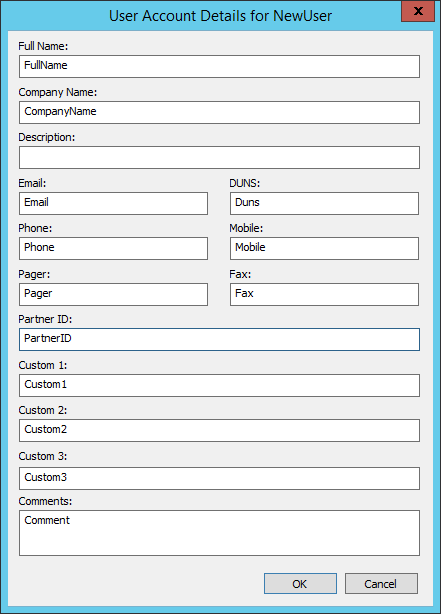 .
.

See also ICISite interface::KickUser and UnlockUser
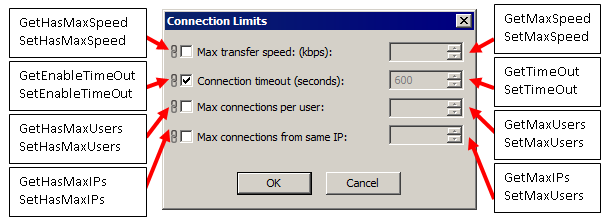
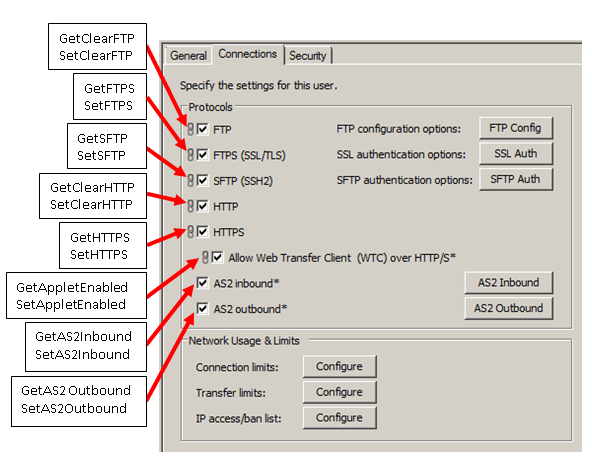
User SFTP Authentication Options
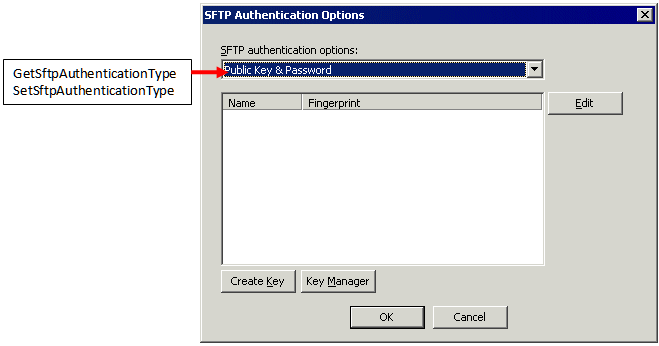
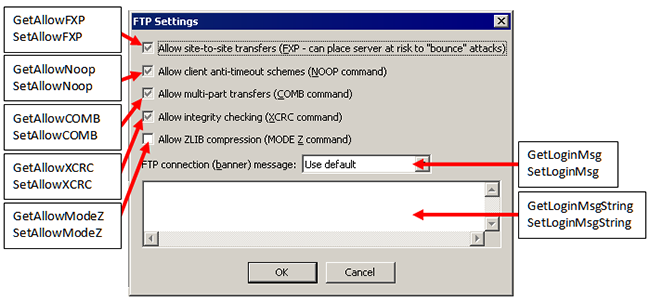
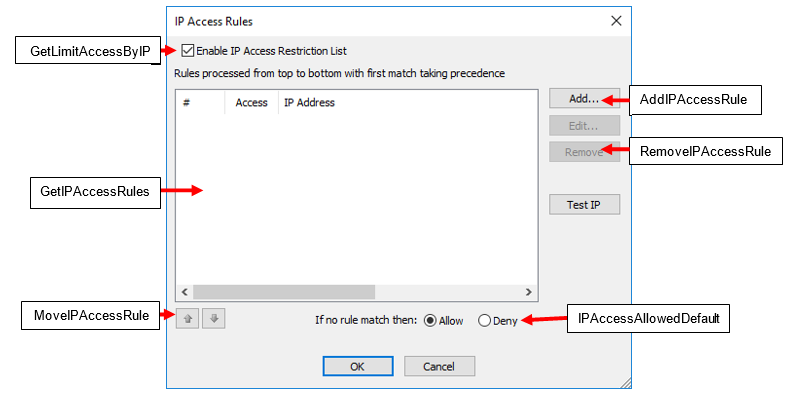

User Security and Password Settings
In 7.3.6 and earlier:
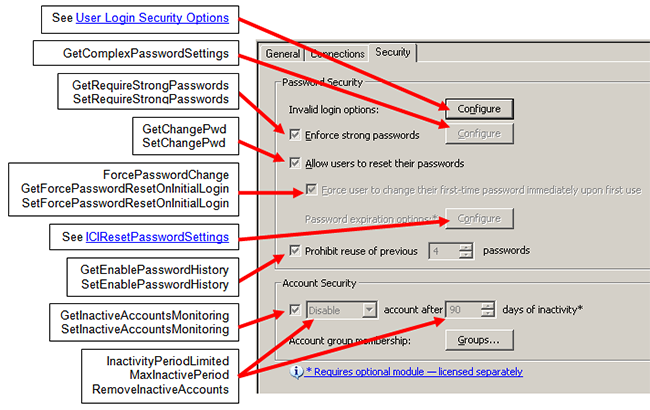
In 7.3.7 and later:

User connection limits in the API include getting/setting the number of uploads and download per session and maximum upload and download sizes. The dialog box below, available from the user's Connections tab, is labeled with some of the transfer limits parameters that are available in the ICIClientSettings interface.

Example of using the Custom property
// eftTestCustomFields.js
// CREATED: 24 May 2007
// Script to confirm use of EFT5 Custom Fields properties
of a CClientSettings in Javascript through API.
//
var args = WScript.Arguments;
if ( args.length < 5 )
{
WScript.Echo("Usage: eftTestCustomFields <eft
host> <eft port> <userid> <password> <user id>\n");
WScript.Echo("Example: cscript eftTestCustomFields.js
192.168.20.101 1100 admin admin foo\n");
WScript.Quit(1);
}
var sHost = args(0);
var iPort = args(1);
var sUser = args(2);
var sPass = args(3);
var sAccountName = args(4);
var server = new ActiveXObject("SFTPCOMInterface.CIServer");
WScript.Echo("Connecting...");
server.Connect(sHost, iPort, sUser, sPass);
WScript.Echo("Connected!");
var site = server.Sites().SiteByID(1);
// for simplicity, assume first site
var oSettings = site.GetUserSettings(sAccountName);
WScript.Echo("Obtained user settings for user account
'" + oSettings.FullName + "' with home directory: " +
oSettings.GetHomeDirString()
);
WScript.Echo("Custom1='" + oSettings.Custom1
+ "'");
WScript.Echo("Custom2='" + oSettings.Custom2
+ "'");
WScript.Echo("Custom3='" + oSettings.Custom3
+ "'");
// Now set the custom fields to new values
WScript.Echo("\nSetting new values...");
oSettings.Custom1 = "Random=" + Math.floor((65535*Math.random()))
+ " [" + (new Date()).toLocaleString() + "]";
oSettings.Custom2 = "Random=" + Math.floor((65535*Math.random()))
+ " [" + (new Date()).toLocaleString() + "]";
oSettings.Custom3 = "Random=" + Math.floor((65535*Math.random()))
+ " [" + (new Date()).toLocaleString() + "]";
server.ApplyChanges();
// Now REQUERY to CONFIRM the custom fields are the new
values
WScript.Echo("Requerying values...");
var oSettings = site.GetUserSettings(sAccountName);
WScript.Echo("\nObtained NEW user settings for user
account '" + oSettings.FullName + "' with home directory: "
+ oSettings.GetHomeDirString() );
WScript.Echo("Custom1='" + oSettings.Custom1
+ "'");
WScript.Echo("Custom2='" + oSettings.Custom2
+ "'");
WScript.Echo("Custom3='" + oSettings.Custom3
+ "'");
server.Close();
WScript.Echo("\nDone");
WScript.Quit(0);